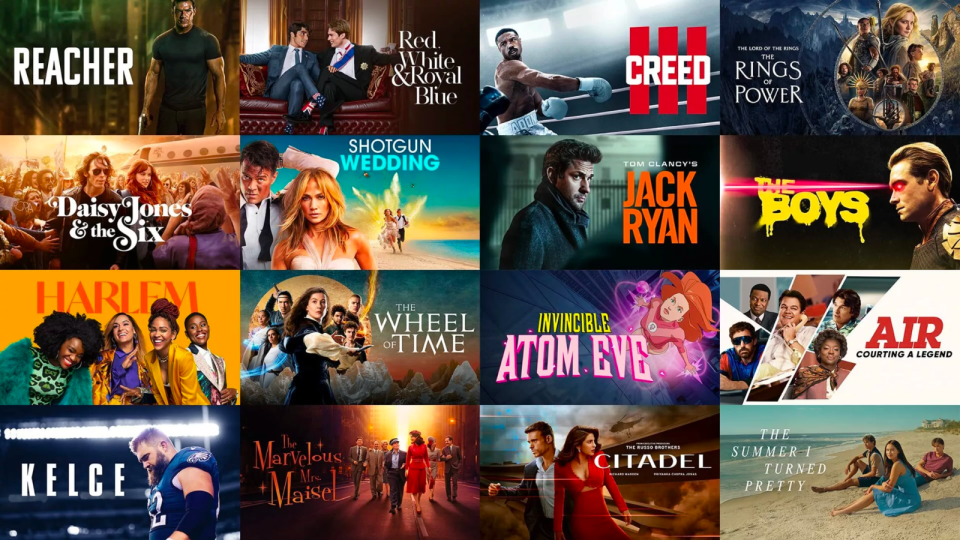Love streaming on Prime? Amazon will now force you to watch ads, unless you pay more
You've had a long day at work. You kick off your shoes, cozy up on your couch with a mug of tea and click over to Amazon Prime Video on your TV, ready to enjoy the new season of "Reacher."
But just as Alan Ritchson's Jack Reacher is about to knock out the latest bad guy with his alarmingly muscled arms, suddenly you're watching an ad for toothpaste or productivity software or sports betting. What the heck just happened?
On Monday, Amazon's streaming service – home to originals like "Reacher," "The Marvelous Mrs. Maisel" and "The Lord of the Rings: Rings of Power" – started serving its customers ads during their favorite TV shows and movies, whether they want them or not. To get rid of the commercials, you'll have to subscribe to a more expensive tier of the service, which will cost an additional $2.99 per month (on top of the current $14.99 a month, or $139 annually).
The company promises to have “meaningfully fewer ads than linear TV and other streaming TV providers,” without being specific. But some ads is more than no ads. Viewers are angry, creators are angry and there isn't even much demand from advertisers themselves, but the change is here nonetheless. Here's everything you need to know about it and why ads are going to become a progressively larger part of the streaming ecosystem.
Why is Amazon forcing me to watch ads?
In short: Money! As streamers work out how to wring more money from subscribers every single day, commercials have become a big part of the strategy. Netflix, which once swore it would never have ads, introduced ad-supported tiers in 2023, and has been pushing them with discounted offers through Verizon Wireless and others. Ads also sprouted up on other previously commercial-free streamers, including Disney+ and Max.
Rather than encourage subscribers to switch to a cheaper version of Prime Video with ads, Amazon decided to make watching ads the default version of the service. So in order to return to a world where "Jack Ryan" isn't interrupted by razor commercials, you'll have to shell out more cash.

This is dumb. What can I do about it?
It is dumb. No doubt about it. It's bad for the consumer experience, and the response from unsuspecting Prime subscribers has been full of righteous anger. No one likes commercials. No one likes something they already pay handsomely for suddenly becoming a worse experience. Especially not when high inflation means paying extra for something you already have hits your wallet harder than it might have in good times.
What can you do about it? Not much. If you want a commercial-free experience, you can pay to upgrade: It will cost $216 per year if you pay monthly or $175 combined with the annual Prime payment. (By comparison, Netflix's standard ad-free tier costs about $186 a year.)
Maybe you'll cancel a streamer you don't watch as much. If you don't want to pay more, you can mute the commercials and deal with it. Heck, living with the commercials is just a good way to teach our kids what TV used to be like. See if you can make to the bathroom and back before the commercial break is over, pretend you can't pause it. Live on the edge.
If you want to show your displeasure, you could cancel Prime, but then you'd lose free two-day shipping, which is probably the main reason a lot of people subscribe to Prime, anyway.
How do Amazon Prime subscribers feel about the ads?
Subscribers are livid, to say the least.
"Amazon's net worth is almost $2 trillion. This is no more than greed. I cancelled," wrote one Reddit user in an expletive-laden thread discussing the change. "I think we're gonna cancel. I don't like rewarding this behavior," said another. "I absolutely hate ads, so I won't be using the service," a third user said. "To me, ads are an imposition that should not be inserted onto a paid platform. By accepting this, where will it end?"
And it's not just subscribers, but the creative talent behind Amazon's content. Lulu Wang, whose TV series "Expats" starring Nicole Kidman just premiered, aired her extreme displeasure. “I’m very angry about that. If I had known, I would’ve created in a different way because it’s not a show that has cliffhangers or commercial breaks to make sure people come back,” Wang told The Hollywood Reporter.

Are there going to be even more ads in streaming?
Unfortunately, yes. Streaming swept onto the media landscape promising to be the TV of the future, without the commercials everyone hates and with brilliant TV shows made by the best creators working with unlimited timeframes and budgets. And it was like that, for a while. Then, in 2022, Netflix lost subscribers for the first time, Wall Street panicked, and streamers suddenly had to show more profits, as opposed to subscriber gains, to make shareholders happy. (After all, capitalism is all about making shareholders happy.) Now it's basically basic cable again, full of bundles, ads and mediocre programming.
What could be next after degrading a subscription with ads? More product placement, more ads per episode or film, all on top of still higher subscription fees. One shouldn't make too many predictions, lest the streamers get more ideas.
This article originally appeared on USA TODAY: Amazon Prime Video now has ads: The unfortunate reason why
